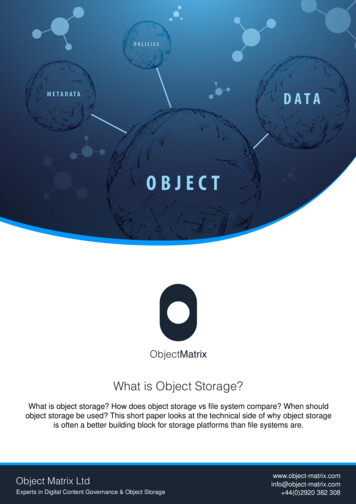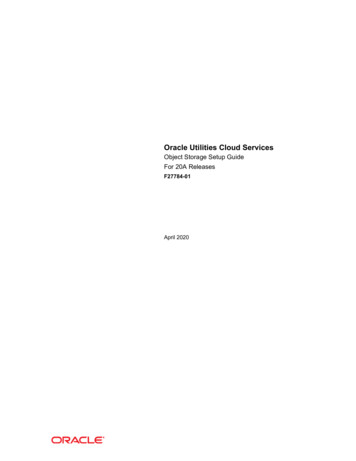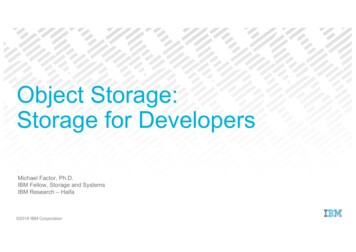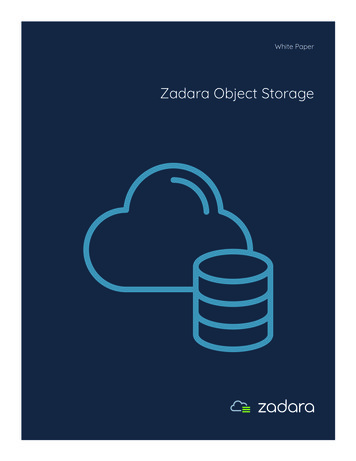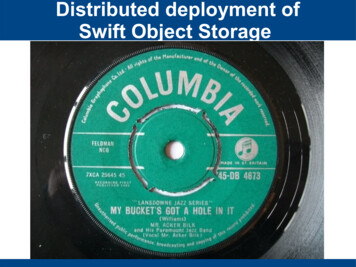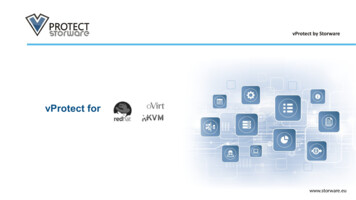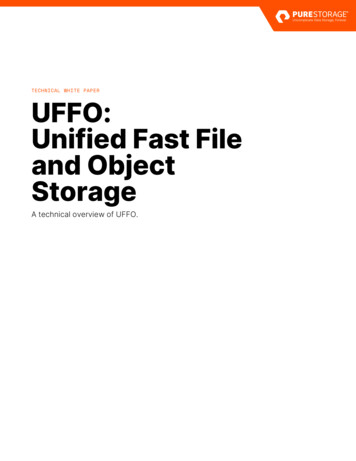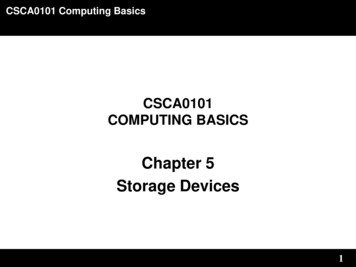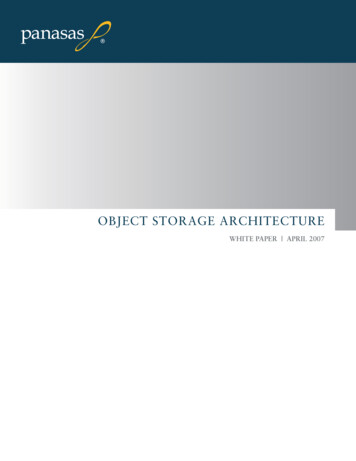
Transcription
OBJECT STORAGE ARCHITECTUREWHITE PAPER APRIL 2007
WHITE PAPER:OBJECT STORAGE ARCHITECTUREAB ST RACTTA B L E O F C O N TE NTSBackground The Linux Cluster Story Aggregate throughput and I/O Shared FilesCurrent Storage Architectures Architectural Breakthrough Parallel data access Distributed MetadataObject Storage Components Objects Object-based Storage Device Distributed File System Metadata Server Network FabricObject Storage Operation READ Operations WRITE OperationsObject Storage Architecture Advantages Performance Scalability Management Security 161617This white paper describes the issuesconfronting Linux compute clusters whenusing today’s storage architectures. Theseissues suggests that a new storage architecturebased on the Object-based Storage Device(OSD) can provide the file sharing capabilityneeded for scientific and technical applicationswhile delivering the performance andscalability needed to make the Linux clusterarchitecture effective. This white paper alsoreviews the components of a storage systembased on objects and the data flow through thesystem in typical storage transactions. Nextit summarizes the advantages of the Objectbased Storage Architecture in the areas ofperformance, scalability, manageability andsecurity. Finally it concludes with a surveyof the history of the project and the currentefforts to create a standard around the Objectbased Storage Architecture.
BAC K U P O V E RV IE WThe Object-based Architecture is based on data Objects, which encapsulate user data (a file) andattributes of that data. The combination of data and attributes allows an Object-based storagesystem to make decisions on data layout or quality of service on a per-file basis, improving flexibilityand manageability. The device that stores, retrieves and interprets these objects is an Object-basedStorage Device (OSD). The unique design of the OSD differs substantially from standard storagedevices such as Fibre Channel (FC) or Integrated Drive Electronics (IDE), with their traditionalblock-based interface. This is accomplished by moving low-level storage functions into the storagedevice and accessing the device through a standard object interface. Object-based Storage Deviceenables: Intelligent space management in the storage layerData-aware pre-fetching, and cachingUltimately, OSD-based storage systems can be created with the following characteristics: Robust, shared access by many clientsScalable performance via an offloaded data pathStrong fine-grained end-to-end securityThese capabilities are highly desirable across a wide range of typical IT storage applications. Theyare particularly valuable for scientific, technical and database applications that are increasinglyhosted on Linux cluster compute systems which generate high levels of concurrent I/O demand forsecure, shared files. The Object-based Storage Architecture is uniquely suited to meet the demandsof these applications and the workloads generated by large Linux clusters.Each organization’s backup requirements are different; the type of backup scheme should bechosen to suit the needs of the organization. All of these backup schemes are a compromisebetween minimizing the backup window and minimizing the time to restore. However the backupis performed, it will have an impact not only on the storage, but also on the systems using thatstorage. Backing up data generated by active applications is not without risks. Although thebackup and restore software may be able to read the data that the application is working on, thatdata may not be in a consistent state. This makes that backup data useless for restore purposesbecause it will put the application in an inconsistent state. A number of backup/restore softwarevendor address these issues by providing agents that cooperate with the applications that run onthe customer’s server to make sure that the backups that are being made are consistent and can beused for restores.The Linux Cluster StoryThe high-performance computing (HPC) sector has often driven the development of new computingarchitectures, and has given impetus to the development of the Object Storage Architecture. Somehistory can provide an understanding of the importance of the Linux cluster systems, whichare revolutionizing scientific, technical, and commercial computing. HPC architectures took afundamental turn with the invention of Beowulf clustering by NASA scientists at the GoddardSpace Flight Center in 1994. Development of the Message Passing Interface (MPI), Beowulfallowed racks of commodity Intel PC-based systems to emulate the functionality of monolithicSymmetric Multi-Processing (SMP) systems. Since this can be done at less than 1/10th the cost ofthe highly specialized, shared memory systems, the cost of scientific research dropped dramatically.Beowulf clusters, now more commonly referred to as Linux clusters, are the dominant computingarchitecture for technical computing, and are quickly gaining traction in commercial industries aswell.3
WHITE PAPER:OBJECT STORAGE ARCHITECTUREUnfortunately, storage architectures have not kept pace, causing systems administrators toperform arduous data movement and staging tasks to get stored data into the Linux clusters.There are two main problems that the storage systems for clusters must solve. First, theymust provide shared access to the data so that the applications are easier to write and thestorage is easier to balance with the compute requirements. Second, the storage systemmust provide high levels of performance, in both I/O rates and data throughput, to meet theaggregated requirements of 100’s and in some cases up to 1000’s of servers in the Linux cluster.Linux cluster administrators have attempted several approaches to meet the need for shared filesand high performance. Common approaches involve supporting multiple NFS servers or copyingdata to the local disks in the cluster. But to date there has not been a solution that effectivelystages and balances the data so that the power of the Linux compute cluster can be brought to bearon the large data sets typically found in scientific and technical computing.Aggregate Throughput and I/ODue to the number of nodes in the cluster, the size of the data sets, and the concurrency of theiraccess patterns, Linux clusters demand high performance from their storage system. As Linuxclusters have matured, the scale of the clusters has increased from 10’s of compute nodes to 1000’sof nodes. This creates a high aggregate I/O demand on the storage subsystem even if the demandof any single node is relatively modest. Applications, such as bioinformatics similarity searching,create demands on the system for very high random I/O access patterns while the compute nodessearch through hundreds of thousands of small files. Alternatively, high-energy physics modelingtypically uses datasets containing files that are gigabytes in size, creating demand on the storagesystem for very high data throughput. In either case, application codes running on many nodesacross the Linux cluster creates a demand for highly concurrent access in both random I/O andhigh data throughput. This level of performance is rarely seen in typical enterprise infrastructuresand cause huge burdens on the storage systems.Shared FilesUnlike the monolithic supercomputers that preceded Linux clusters, the data used in the computeprocess must be available to a large number of the nodes across the cluster simultaneously. Sharedaccess to storage lowers the complexity for the programmer by making data uniformly accessiblerather than forcing the programmer to write the compute job for the specific node that has directaccess to the relevant portion of the dataset. Similarly, shared data eliminates the need for thesystem administrator to load the data to specific locations for access to the compute nodes or tobalance the storage traffic in the infrastructure.In many applications the project is not a single analysis of a single dataset, but rather a series ofanalyses combining multiple datasets, where the results of one process provide inputs to the next.For example, geologic information in the oil and gas industry typically takes the raw seismic tracesfrom time and depth migration analysis, and combines them with well-head information to create4-Dimensional (4D) visualizations. Given the size of the data and results sets, simply moving theinformation between local and/or network storage systems could add days to the completion of theproject and increase the likelihood of error and data loss.Sharing files across the Linux cluster substantially decreases the burden on the scientist writingthe programs and the system administrator trying to optimize the performance of the system.However, providing shared access to files requires that there be a central repository for the filelocations, known as the storage system metadata server, to track where each block of every file is4
stored on disk and which node of the cluster is allowed to access that file. If the metadata serveralso sits on the data path between the cluster nodes and the disk arrays, as nearly all file serverstoday are designed, it becomes a major bottleneck for scaling in both capacity and performance.C U R R EN T S TO RAGE A R CHITE CTU RESThere are two types of network storage systems, each distinguished by their command sets. Firstis the SCSI block I/O command set, used by Storage Area Networks (SANs), which provides highrandom I/O and data throughput performance via direct access to the data at the level of the diskdrive or fibre channel. Second, the Network Attached Storage (NAS) systems that use NFS orCIFS command sets for accessing data with the benefit that multiple nodes can access the data asthe metadata on the media is shared. Linux clusters require both excellent performance and datasharing from their storage systems. In order to get the benefits of both high performance and datasharing, a new storage design is required that provides both the performance benefits of directaccess to disk and the ease of administration provided by shared files and metadata. That newstorage system design is the Object-based Storage Architecture.Architectural BreakthroughThe Object Storage Architecture combines the two keyadvantages of today’s storage systems, performance and filesharing. When combined, these advantages eliminate thedrawbacks that have made their previous solutions unsuitablefor Linux cluster deployments.First, the Object Storage Architecture provides a method forallowing compute nodes to access storage devices directlyand in parallel providing very high performance. Second, itdistributes the system metadata allowing shared file accesswithout a central bottleneck. The Object Storage Architectureoffers a complete storage solution for Linux clusters withoutthe compromises that today’s storage systems require in eitherperformance or manageability.Parallel Data AccessThe Object Storage Architecture defines a new, more intelligent disk interface called the Objectbased Storage Device (OSD). The OSD is a network-attached device containing the storage media,disk or tape, and sufficient intelligence to manage the data that is locally stored. The computenodes communicate directly to the OSD to store and retrieve data. Since the OSD has intelligencebuilt in there is no need for a file server to intermediate the transaction. Further, if the file systemstripes the data across a number of OSDs, the aggregate I/O rates and data throughput rates scalelinearly. For example, a single OSD attached to Gigabit Ethernet may be capable of delivering400 Mbps of data to the network and 1000 storage I/O operations, but if the data is striped across10 OSDs and accessed in parallel, the aggregate data rates achieve 4,000 Mbps and 10,000 I/Ooperations. These peak rates are important, but for most Linux cluster applications, the aggregatesustained I/O and throughput rates from storage to large numbers of compute nodes are even moreimportant. The level of performance offered by the Object Storage Architecture is not achievableby any other storage architecture.5
WHITE PAPER:OBJECT STORAGE ARCHITECTUREDistributed MetadataCurrent storage architectures are designed with a single monolithic metadata server that servestwo primary functions. First, it provides the compute node with a logical view of the stored data(the Virtual File System or VFS layer), the list of file names, and typically the directory structurein which they are organized. Second, it organizes the data layout in the physical storage media(the inode layer).The Object Storage Architecture divides the logical view of the stored data (VFS layer) from thephysical view (the inode layer) and distributes the workload allowing the performance potential ofthe OSD to avoid the metadata server bottlenecks found in today’s NAS systems. The VFS portionof the metadata typically represents approximately 10% of the workload of a typical NFS server,while the remaining 90% of the work is done at the inode layer with the physical distribution ofdata into storage media blocks.In the Object Storage Architecture, the inode work is distributed to each intelligent OSD. EachOSD manages the layout and retrieval of the data that is presented to it. It maintains the metadatathat associates the objects (files or portions of files) with the actual blocks on the storage media.Thus 90% of the metadata management is distributed among the intelligent storage devices thatactually store the data. If a file is striped across ten OSDs, no single device has to do more than10% of the work that a conventional metadata server must perform in a today’s NAS systems orfile servers. This provides an order of magnitude improvement in the performance potential forthe system’s metadata management. In addition, because the metadata management is distributed,adding more OSDs to the system increases the metadata performance potential in parallel with theincreased capacity of the system.O BJ EC T STO R AGE CO MPO NE NTSThere are five major components to the Object Storage Architecture. Object - Contains the data and enough additional information to allow the data to beautonomous and self-managing.Object-based Storage Device (OSD) - An intelligent evolution of today’s disk drive thatcan store and serve objects rather than simply putting data on tracks and sectors.Installable File System (IFS) - Integrates with compute nodes, accepts POSIX file systemcommands and data from the Operating System, address the OSDs directly and stripesthe objects across multiple OSDs.Metadata Server - Intermediates throughout multiple compute nodes in the environment,allowing them to share data while maintaining cache consistency on all nodes.Network Fabric - Ties the compute nodes to the OSDs and Metadata Servers.ObjectsThe Object is the fundamental unit of data storage in this system. Unlike files or blocks, whichare used as the basic components in conventional storage systems, an object is a combination offile data plus a set of attributes that define various aspects of the data. These attributes can defineon a per file basis the RAID levels, data layouts, and quality of service. Unlike conventional blockstorage where the storage system must track all of the attributes for each block in the system, theobject maintains its own attributes to communicate with the storage system how to manage eachparticular piece of data. This simplifies the task of the storage system and increases its flexibility6
by distributing the management of the data with the data itself.Within the storage device, all objects are accessed via a 96-bit object ID. The object is accessedwith a simple interface based on the object ID, the beginning of the range of bytes inside theobject and the length of the byte range that is of interest ( object, offset, length ). There arethree different types of objects. The “Root” object on the storage device identifies the storagedevice and various attributes of the device itself, including it’s total size and available capacity. A“Group” object provides a “directory” to logical subset of the objects on the storage device. A“User” object carries the actual application data to be stored.The user object is a container for data and two types of attributes. Application Data - The application data is essentially the equivalent to the data that a filewould normally have in a conventional system. It is accessed with file-like commandssuch as Open, Close, Read, and Write.Storage Attributes – These attributes are used by the storage device to manage the blockallocation for the data. This includes the object ID, block pointers, logical length,and capacity used. This is similar to the inode-level attributes inside a traditional filesystem. There is also a capability version number used when enforcing access controlto objects.User Attributes – These attributes are opaque to the storage device and are used byapplications and metadata managers to store higher-level information about the object.These attributes can include file system attributes like ownership and access controllists (ACLs), which are not directly interpreted by the storage device as described later.Attributes can describe Quality of Service requirements that apply specifically to agiven object. These attributes can tell the storage system how to treat an object, forinstance what type of RAID to apply, the size of the capacity quota or the performancecharacteristics required for that data.Object-based Storage DeviceThe Object-based Storage Device represents the next generation of disk drives for network storage.The OSD is an intelligent device that contains the disk, a processor, RAM memory and a networkinterface that allows it to manage the local object store, and autonomously serve and store datafrom the network. It is the foundation of the Object Storage Architecture, providing the equivalentof the SAN fabric in conventional storage systems. In the “Object SAN,” the network interface isgigabit Ethernet instead of fibre channel and the protocol is iSCSI, the encapsulation of the SCSIprotocol transported over TCP/IP. SCSI supports several command sets, including block I/O, tapedrive control, and printer control. The new OSD command set describes the operations availableon Object-based Storage Devices. The result is a group of intelligent disks (OSDs) attached toa switched network fabric (iSCSI over Ethernet) providing storage that is directly accessible bythe compute nodes. Unlike conventional SAN configurations, the Object Storage Devices can bedirectly addressed in parallel, without an intervening RAID controller, allowing extremely highaggregate data throughput rates.The OSD provides four major functions for the data storage architecture: Data Storage – The primary function in any storage device is to reliably store andretrieve data from physical media. Like any conventional storage device; it must managethe data as it is laid out into standard tracks and sectors. The data is not accessibleoutside the OSD in block format, only via their object IDs. The compute node requests7
WHITE PAPER:OBJECT STORAGE ARCHITECTURE 8a particular object ID, an offset to start reading or writing data within that object andthe length of the data block requested.Intelligent Layout – The OSD uses its memory andprocessor to optimize the data layout on the disk andpre-fetching of data from the disk. The object andits protocol provide additional information aboutthe data that is used to help make layout decisions.For example, the object metadata provides the lengthof data to be written, allowing a contiguous set oftracks to be selected. Using a write-behind cache, alarge amount of the write data can then be cached andwritten in a small number of efficient passes across thedisk platter. Similarly the OSD can do intelligent readahead or pre-fetching, of the blocks for an object andhave them available in buffers for maximum accessperformance.Metadata Management – The OSD manages themetadata associated with the objects it stores. Thismetadata is similar to conventional inode dataincluding the blocks associated with an object andthe length of the object. In a traditional system, thisdata is managed by the file server (for NAS) or by thehost operating system (for direct-attached or SAN).The Object Storage Architecture distributes the work of managing the majority of themetadata in the storage system to the OSDs and lowers the overhead on the host computenodes. The OSD also reduces the metadata management burden on the Metadata Serverby maintaining one component object per OSD, regardless of how much data thatcomponent object contains. Unlike traditional systems where the Metadata Server musttrack each block in every stripe, on every drive; successive object stripe units are simplyadded to the initial component object. The component objects grow in size, but for eachobject in the system, the Metadata Server continues to track only one component objectper OSD reducing the burden on the Metadata server, and increasing its scalability.Security – There are two ways the object protocol improves security over SAN orNAS network storage systems. First, object storage is a network protocol and like anynetwork transaction (SAN or NAS) it is potentially vulnerable to an external attack. Inaddition, it allows distributed access to the storage array from the host nodes (similarto a SAN), which can allow a node to intentionally or unintentionally (via an operatingsystem failure) attempt to write bad data or into bad locations. Implementing the OSDarchitecture takes security to a new level by eliminating the need to trust clients externalto the system. Each command or data transmission must be accompanied by a capabilitythat authorizes both the sender and the action. The capability is a secure, cryptographictoken provided to the compute node. The token describes to the OSD, which objectthat the compute node is allowed to access, with what privileges, and for what lengthof time. The OSD inspects each incoming transmission for the proper authorizationcapabilities and rejects any that are missing, invalid or expired.
D i s t ri b u t ed Fil e S y s temIn order for the compute nodes to read and write objects directly to the OSDs, an installable filesystem must be deployed. The distributed file system provides four key functions in the ObjectStorage Architecture. POSIX File System Interface – The distributed file system must provide a transparentinterface to the applications above it. The distributed file system will provide a POSIXinterface to the application layer which allows the application to perform standardfile system operations such as Open, Close, Read and Write files to the underlyingstorage system. In addition, it must support a full set of permissions and access controlsexpected by Linux applications, allowing it to have exclusive or shared access to anygiven file.Caching – The distributed file system must provide caching in the compute node forincoming data complementing the cache in the OSD. There will also be a cache forwrite data that aggregates multiple writes for efficient transmission and data layout atthe OSDs. A third cache must be maintained for metadata and security tokens, so thatthe client can quickly generate secure commands to access data on the OSDs for whichthey have been given permission.Striping/RAID – The distributed file system musthandle the striping of objects across multipleOSDs on a per object basis. Unlike standardRAID arrays, an object distributed file systemcan apply a different data layout and RAID levelto each object. The distributed file system takesan object and breaks it down to componentobjects, which are the subset of an object sent toeach OSD. The size of each component object(stripe unit size) is specified as an attribute of theobject. The stripe width, or the number of OSDsthat the object is striped across, is also specifiedas an attribute of the object. Because the objectis read or written in parallel, the width of thestripe will correlate directly to the bandwidth ofthe object. If RAID is specified, the parity unitwill be calculated by the client and applied tothe object stripe.iSCSI – The distributed file system must implement an iSCSI driver which encapsulatesthe SCSI command set, the Object extensions to the command set and the data payloadacross a TCP network in order to transmit and receive data from the OSDs. TCP/IP accelerators (called TCP Offload Engines or TOE) can provide the iSCSI and TCPprotocol processing which offloads TCP and iSCSI processing from the compute nodeto the TOE adapter.Mount – All clients mount the file system at the root, using access controls to determineaccess to different portions of the file tree. Authentication mechanisms are requiredsuch as Kerberos, Windows NTLM, and Active Directory. The identity of the computenodes must be maintained via these authentication mechanisms, UID/GIDs for Unix andSIDs for Windows systems.Additional file system interfaces – Beyond a POSIX interface, other application interfacessuch as Message Passing Interface for I/O (MPI-IO) may be useful. This interface allowsparallel application writers to more efficiently control the layout of the data across9
WHITE PAPER:OBJECT STORAGE ARCHITECTUREthe OSDs via low-level ioctls in the file system. This can be useful for creating verywide stripes for massive bandwidth or to allow cluster checkpointing to a single file formaximum restart flexibility. Two MPI-IO implementations are widely used, MPICH/ROMIO from Argonne Labs and MPI Pro from MSTI, which will also support the MPI2 standard.Me t adat a S er verThe Metadata Server (MDS) controls the interaction of the compute nodes with the objects on theOSDs by coordinating access to nodes that are properly authorized. The MDS is also responsiblefor maintaining cache consistency for users of the same file. In NAS systems, the metadata server(filer head) is an integral part of the data path, causing significant bottlenecks as traffic increases.The Object Storage approach removes the Metadata Server from the data path allowing highthroughput and more linear scalability that are typically associated with SAN topologies that allowclients to interact directly with the storage devices. The Metadata Server provides the followingservices for the Storage Cluster: 10Authentication – The first role of the MDS is to identify and authenticate Object-basedStorage Devices wishing to join the storage system. The MDS provides credentialsto new storage system members and checks/renews those credentials periodically toassure that they are valid members. Similarly when a compute node wants access to thestorage system, the MDS assures its identity and provides authorization. In the case ofa compute node, it must turn the work of authentication over to an external service,which provides this service for the organization at large.File and Directory Access Management – The MDS provides the compute node with thefile structure of the storage system. When the node requests to perform an operation ona particular file, the MDS examines the permissions and access controls associated withthe file and provides a map and a capability to the requesting node. The map consistsof the list of OSDs and their IP addresses, containing the components of the object inquestion. The capability is a secure, cryptographic token provided to the compute node,which is examined by the OSD with each transaction. The token describes to the OSD,which object that the compute node is allowed to access, with what privileges, and forwhat length of time.Cache Coherency – In order to achieve maximum performance, compute nodes willnormally request the relevant object, and then work out of locally cached data. If thereare multiple nodes using the same file, steps must be taken to assure that the local cachesare updated if the file is changed by any of the nodes. The MDS provides this servicewith distributed object locking or callbacks. When a compute node asks for Read orWrite privileges to a file or a portion of a file from the MDS, a callback is registeredwith the MDS. If the file privileges allow multiple writers, and is modified by anothernode, the MDS generates a callback to all of the nodes that have the file open, whichinvalidates their local cache. Thus, if the node has Read access to a file that has beenupdated, it must go back to the OSDs to refresh its locally cached copy of that data,thereby assuring that all nodes are operating with identical data.Capacity Management – The MDS must also track the balance of capacity and utilizationof the OSDs across the system to make sure that the overall system makes optimum useof the available disk resources. When a compute node wants to create an object, theMDS must decide how to optimize the placement of the new file as it authorizes thenode to write the new data. Since the node does not know how large the file will be atthe time of file creation, the MDS provides the node with an escrow, or quota, of space.This allows the node to maximize the performance of the write operation by creating
and writing data in one step. Any excess quota is recovered once the file is closedmaintaining maximum performance during the critical write operations.Scaling - Metadata management is the key architectural issue for storage systemsattempting to scale in capacity and performance. Because the Object Storage Architectureseparates file/directory management from block/sector management, it can scale to levelsgreater than any other storage architecture. It distributes the block/sector managementto the OSDs (which is approximately 90% of the workload) and maintains the file/directory metadata management (10% of the workload) in a separate server that can alsobe implemented as a scalable clu
The Object Storage Architecture offers a complete storage solution for Linux clusters without the compromises that today's storage systems require in either performance or manageability. Parallel Data Access The Object Storage Architecture defines a new, more intelligent disk interface called the Object-based Storage Device (OSD).

